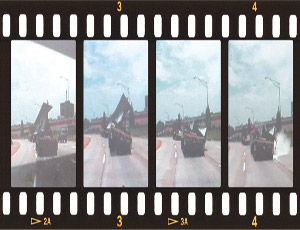The Louisiana State Police say a driver hauling a 134-ft-long 78-in.-deep, pre-stressed bulb-T girder was going too fast and his load was not properly secured when it fell off a truck in New Orleans, La., on June 22. There were no injuries. The driver was fined $100.

“The load came undone, so it was not secured properly,” says State Police spokesman Lt. Doug Cain. “Whether that is attributed totally to speed or tie downs, I don’t think we’ll ever know.”
That might have been the end of it, except the dashboard video camera of State Police Trooper Dustin Dwight, providing rear escort, captured the accident, and now the video has captured attention on the Web. Cargo haulers are intrigued by the frame-by-frame replays.
“I would like to know, [how this happened], and what should we do as an association?” says Doug Ball, transportation vice president with the Specialized Carriers and Riggers Association, Fairfax, Va. “It’s certainly a training tool [that says], �this is why it happened and to prevent this, these are the steps you need to take,’” He spoke of screening the video as an example at the SCRA’s next convention.
Christopher Adams, 37, owner and driver for Express One Transport, Andalusia, Ala., was cited for “failure to stop cargo from shifting or falling,” according to the crash report filed by investigating officer Arthur Laurent. Adams was given 45 days to either pay the fine or request a hearing.
Cain says video analysis shows Adams was “going about 45 mph in a 35 mph zone.” Adams says it was a bad curve, but he never exceeded 25 mph and the load was properly secured.
Adams refers to it as a “freak accident” that likely resulted from “four or five contributing factors that had to meet up at the perfect time.”
“Once the truck left the interstate, that truck never made it up to 40 mph,” Adams says, citing the fact that he had a state police escort as evidence. “There’s a curve involved there, and possibly some mechanical issue, some piece that broke,” Adams adds.
“That truck passed all inspections and met the state police standards for tying down,” Adams adds. “That roll in the road contributed to it a lot. If you watch the video, you can see the chains break at the last minute.”
Adams, who picked up the girder from supplier Gulf Coast-Pre-Stress, Inc., Pass Christian, Miss., says he’s “done hundreds of these loads without scratching one,” and that the incident is the company’s first.
The girder was bound for Phase IV of the $1.2 billion Huey P. Long Bridge widening project in New Orleans. Adams says he has made previous deliveries to the project without incident.
The accident occurred less than a mile from the bridge. According to the trooper’s report, Adams was traveling south in the center left lane of the four-lane roadway when his load shifted about 1:15 p.m, fell to the roadway and slid 113 ft.
Bambi Hall, spokeswoman for the Louisiana Dept. of Transportation and Development, says the girder caused minor scraping to the roadway, broke a small segment of curb and separated a light pole.
Whether it was the road, the speed or a combination of events, Adams is at fault for the crash, says Melissa Matey, Louisiana State Police public affairs in Kenner, La. “If you lost control of your vehicle, you’d get cited for careless operation.”
SCRA’s Ball accepts that, but says he is still troubled by the lack of a more detailed explanation or evidence of a deeper investigation, particularly because the safety of the motoring public is at stake. “That’s part of our mission responsibility, to keep harping on this. These things can happen—so we need to know, how did it happen? And what can we do to prevent it from happening? Do you need to re-evaluate the equipment you are using in driving?”
“It appears the driver did not adhere to the procedures regarding speed, weather or road conditions, and you try to prepare for freak accidents; but this isn’t a freak accident. It’s going straight down the road and you enter a turn and you lose your load. That’s quite a load—but that’s why you have these procedures...and that why the load-securement standards are there, but if you don’t put all the elements together, then these things can happen.”
Standards for securing cargo are set by U. S. Dept. of Transportation. A driver’s handbook, with hotlinks from the table of contents, is available at http://www.fmcsa.dot.gov/safety-security/safety-initiatives/cargo/cs-manual-intro.htm.
“When the driver accepts a load, he is responsible for the care and maintenance of that load,” says Martin Frisard, owner of Frisard’s Trucking, Inc., Gramercy, La. and chairman of the board for the Louisiana Motor Transport Association. Frisard says, from looking at the video, it appears Adams was traveling too fast, which resulted in the shift and the failure of the tie-downs.
However, Frisard agrees that the curve in the road is a likely culprit as well. “That is one of the worst curves that I have ever driven,” says Frisard, recalling his own near accident in the same location. “I almost lost one of my 18-wheelers in 1985. I was lucky. That is one of the meanest curves I have ever seen, and it hits you quick.”
Vibration of the road and bumps can contribute to loss of control as well as speed, length of carrier, and length and weight of the load, Frisard adds. “There are so many factors going into it, so it’s hard to say until they get all the information together.”
Jodi Conachen, communications director for the La. DOTD, says the department will review the area where the accident occurred, as well as the whole approach corridor leading to the bridge before the widening project is finished in 2013.
"Anytime there are traffic accidents on a particular roadway or intersection, especially this serious, we do a review," she says.
The contractor who was waiting to receive the girder is KMTC, a joint venture of Peter Kiewit Sons’, Inc. Omaha, Neb., Massman Construction Co., Kansas City, Mo. and Traylor Brothers, Inc., Evansville, Inc.
Since KMTC had not taken delivery of the girder, “our role is somewhat limited,” says Kent Grisham, spokesman for Kiewit Corporation. “A cooperative investigation continues that includes law enforcement, regulatory authorities, our business affiliates and us,” he says, although he added that the JV was not conducting it. “However, any lessons learned from that investigation will be useful in preventing such accidents in the future.” Looking at the video, it’s amazing that the roadway was so traffic free and no one was injured, Frisard says. “Thank God nobody got hurt. That’s the main thing right there,” he says. “Maybe it’s an alert that somebody needs to look at that curve. It’s a bad curve.”



Post a comment to this article
Report Abusive Comment